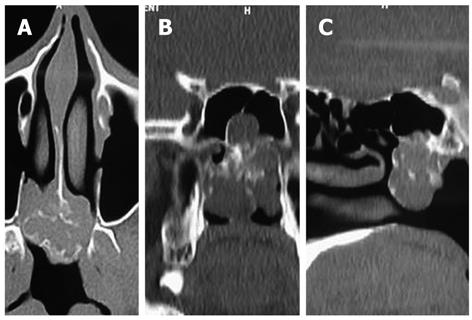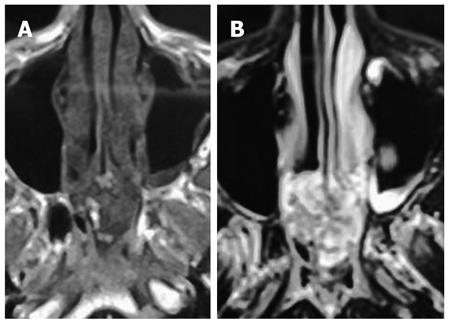Copyright
©2012 Baishideng Publishing Group Co.
World J Radiol. Jun 28, 2012; 4(6): 283-285
Published online Jun 28, 2012. doi: 10.4329/wjr.v4.i6.283
Published online Jun 28, 2012. doi: 10.4329/wjr.v4.i6.283
Figure 1 Non-contrast computed tomography of the paranasal sinuses.
A: Axial non-contrast computed tomography shows a soft tissue mass of the sphenoid sinus causing blockade of the posterior choanae. There is pleomorphic calcification in the center as well as the periphery of the mass not conforming to a particular type of matrix mineralization; B: Coronal reformation shows the origin of the mass from the floor of the sphenoid sinus; C: Sagittal reformation also demonstrates the mass arising from the floor of the sphenoid sinus.
Figure 2 Magnetic resonance imaging of the skull base in the same patient.
A: Axial T1-weighted magnetic resonance imaging (MRI) demonstrates the hypointense mass arising from the sphenoid sinus; B: On axial T2-weighted MRI, the mass is predominantly hyperintense with a few hypodense areas.
Figure 3 Gadolinium enhanced magnetic resonance imaging of the skull base in the same patient.
A: Coronal magnetic resonance imaging (MRI) image shows the origin of the mass from the sphenoid floor with peripheral rim enhancement; B: Sagittal MRI also demonstrates the peripheral rim enhancement.
Figure 4 Contrast-enhanced computed tomography of the face and neck.
A: Axial contrast-enhanced computed tomography (CECT) section in soft tissue settings at the level of the maxillary antra reveal a lobulated soft tissue mass in the right parapharyngeal space with abundant chondroid matrix; B: An axial CECT bone window setting shows no destruction of the mandible; C: Coronal reformatted section in the bone window setting shows the pressure effect of the mass over the right mandible causing scalloping of the inner cortex of the condyle and the body.
- Citation: Gupta P, Bhalla AS, Karthikeyan V, Bhutia O. Two rare cases of craniofacial chondrosarcoma. World J Radiol 2012; 4(6): 283-285
- URL: https://www.wjgnet.com/1949-8470/full/v4/i6/283.htm
- DOI: https://dx.doi.org/10.4329/wjr.v4.i6.283












